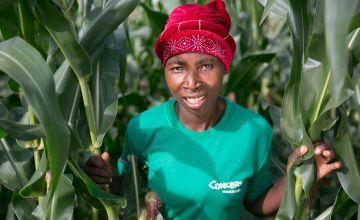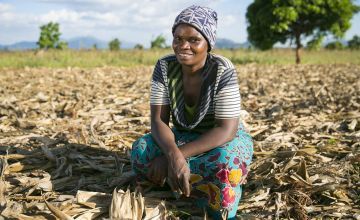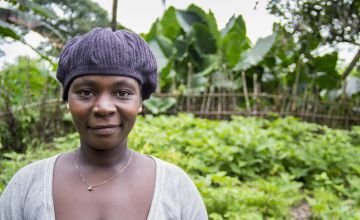
Read our 2023 annual report

Knowledge Hub
Not all solutions need to be high-tech. Going back to the basics in agriculture is transforming bare fields into bountiful harvests. Here’s how.
Here’s what we know from the data: 65% of the world’s adult workforce living below the poverty line rely on agriculture, according to a recent World Bank study. The World Bank also estimates that, compared to other sectors, investing in this sector is two to four times more effective at raising incomes among the world’s poorest. However, climate change is a major threat to progress in this area, especially where it’s needed most.
Here’s what we know from our work: The effects of climate change are clear. Concern Malawi’s Chris Njima explains the domino effect a few seasons of bad rains has on a family here: 'It means less food on the table for longer periods, with families either skipping meals or eating smaller portions.' This scenario brings with it the threat of chronic malnutrition and child stunting. As many as 1 million children under 5 in Malawi are stunted; their height is lower than average for their age. Over 60% of the country’s children are anemic due to poor diets which are, in turn, due to poor harvests, which are due to climate change, which…
You get the idea. It’s a complex problem. Climate Smart Agriculture isn’t here to solve it, but it is providing an essential service.
What is Climate Smart Agriculture?
Climate Smart Agriculture (CSA) is a set of farming methods designed to increase the resilience and productivity of land affected by climate change. It’s a new name for something that has actually been around for quite a long time. But it's now proving especially useful in some of the countries most affected by climate change, from Afghanistan to Zambia.
Before we go any further, it’s important to note: Climate Smart Agriculture isn’t a solution to climate change. But it is a solution to many of the secondary and tertiary problems caused by climate shocks.
Concern’s approach to CSA involves working with farmers so that they can better use and manage the natural resources available to them. We also work with them to find more efficient methods, based on their land and climate, of producing, processing, and even marketing their harvests.

The benefits of Climate Smart Agriculture
This multi-faceted approach to CSA offers farmers and their families the opportunity for a 'triple win':
- Better food security for farmers and their families
- Farmers are more prepared to handle current and future effects of climate change
- Where possible and when it benefits the farmers we work with, reduced greenhouse gas
But the benefits go beyond these three key outcomes, as Esime Jenaia, a CSA farmer who Concern worked with in Malawi, tells us: 'With the same field, I used to harvest one bag of maize, but now I harvest eight bags.' Her children go to school with full bellies and, thanks to the income generated from selling the extra maize, all of the books and supplies they need. This is especially important for Esime who hopes her children will 'realise the importance of getting an education' and become independent.

With the same field, I used to harvest one bag of maize, but now I harvest eight bags.
Taking on Climate Smart Agriculture has also boosted Esime’s independence, along with her self-respect and happiness. Having grown up in poverty, she is now a successful businesswoman in her community. She teaches the methods of her success to neighbours and people from surrounding villages, many of whom are women. This, in turn, has fostered a change in gender dynamics in her area of Malawi.
'There’s a difference in the way women lived then and now,' she says. 'We used to depend on men to do everything. But now women are independent. We are able to support our own needs… and now we are even able to buy trousers for the husband!'

Climate Smart Agriculture techniques
So what exactly are these secrets to success for Esime (and hundreds of thousands of farmers like her)? The focus often changes depending on the country or community and the specific challenges it faces. But the main techniques and areas of focus for Climate Smart Agriculture are:
1. Conservation Agriculture
Conservation agriculture is a soil management practice based on three principles: crop rotation, no tillage (or minimal tillage if needed), and mulching and soil cover. In other words, it involves planting seeds in small holes (instead of furrows), using the stalks from last year’s crops to cover the ground, and alternately setting plants like legumes to replenish the nutrients sucked out of the soil by a crop like maize. In the end, this preserves fertility. For busy mums like Esime, it also means less labor during the planting season and a new supply of alternative crops which just happen to be a good source of nutrition for young children.

There’s a difference in the way women lived then and now. We used to depend on men to do everything. But now women are independent. We are able to support our own needs.
2. Improved crop variety & diversification
Diversifying crops is, as mentioned above, a great way to not only diversify a family’s diet, but also gives the soil some nutritional benefits. But we can also improve the quality of the crops already being planted.
To increase harvest yields and make farms more resistant to the effects of climate change, we can focus on crop varieties that have improved traits, such as tolerance to crop disease or shorter growth cycles. We often use short-cycle crops in response to natural disasters, such as 2019’s Cyclone Idai, when crops are washed away between planting and harvest. These crops are also more drought resistant since they mature early.
3. Soil & water management
Another tried-and-true CSA method uses special hole and pit-digging methods, or, on the opposite end of the spectrum, raised mounds of earth, to collect, divert, or slow down the flow of water during seasonal rainfalls. These simple interventions can reduce water loss as well as soil erosion. By 'hacking' the ground (in some cases literally), we can keep moisture in the soil for longer periods of time, ultimately increasing harvests in drylands.
4. Irrigation
Likewise, in the off-season we can extend the use of water for livestock and crops. In Somaliland, we’ve developed a system with farmers to collect rainfall with a plastic-lined basin. This has allowed farmers to successfully grow in the off-season.
Previously in Nepal, our WASH programme installed sprinklers that are used for irrigation, while in Zambia we provided tread pumps to make pumping water from nearby streams an easy task. And in Niger, we’ve made use of one of the most abundant natural resources — sunlight — to run solar-powered pump systems. These have allowed families to thrive, nutritionally and financially, with high-value vegetable crops.
5. Agroforestry
Like the landscape painter Bob Ross said, sometimes adding a few 'happy little trees' makes a big difference. Agroforestry involves planting trees and shrubs on farms. Depending on the species and the goals, this can improve soil fertility and stability, produce firewood, and grow new crops like fruits and medicinal plants.
6. Post-Harvest Management
The world currently produces enough food to feed all of its inhabitants, but crop loss and spoilage is one of the main causes of food insecurity. As such, we work with farmers to improve harvesting techniques, and the storage, handling, transportation, processing, and packaging of their crops.
The goal with this is to reduce crop losses and spoilage at each step of the supply chain, which ultimately improves food security. For instance, in Pakistan, we began to promote the use of hermetic bags and drums for transporting crop harvests. These containers minimise oxygen in the crops, which reduces food loss due to insects or fungi.

Farmer to farmer
Techniques and tools aren’t enough to guarantee the success of Climate Smart Agriculture. True empowerment in agriculture happens when farmers have the skills, knowledge, and well-being to evaluate and make their own informed decisions about their farming practices.
This is why Concern’s approach to CSA also focuses on extension programmes that place education and knowledge-sharing in the hands of farmers like Esime. Generally most techniques don’t need to be followed to the letter, and we encourage farmers to conduct their own experiments. This is also a key way of making sure that this is something that they can continue without Concern’s continued support. They’ve made it their own.
Climate Smart Agriculture won’t 'fix' climate change. But it has made life better for many of the families hit hardest by the climate crisis, giving them a simple and effective way of coping. Those who have learned the techniques are passing it on to their neighbours — and there’s no shortage of people who have seen the impact for themselves and want to replicate it.

